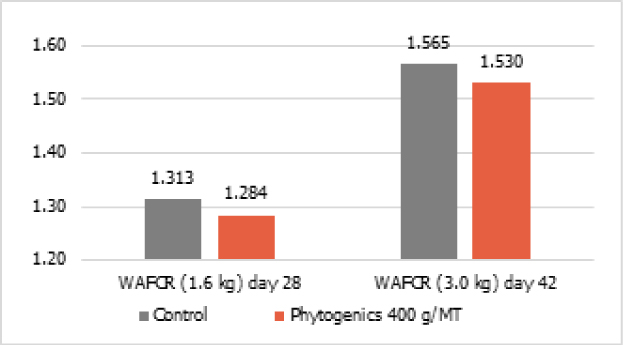The rising global human population and improving human welfare standards increase demand for animal proteins. The intestine, the seat of health, also in animals, constitutes the center of health, which must be taken care of.
By Manu De Laet : Several trials have shown that the inclusion of phytogenic feed additives in feed enhances the performance of broilers. Alongside improved performance, the gut resilience of birds will also be beneficially influenced. Since digestion of the feed is improved using phytogenic feed additives, fewer nutrients should be available for undesirable bacteria. This limits their population growth and the detrimental consequences typically associated with this uncontrolled growth.
Next to limiting undesirable bacteria population growth, phytogenics can influence intestinal resilience via another strategy.
Quorum sensing (QS), or bacterial cell-to-cell communication, is a mechanism of gene regulation in which bacteria coordinate the expression of specific genes in response to the presence of small signaling molecules (inducers). This regulatory mechanism has been shown to control virulence gene expression in many different pathogens. Virulence factors include gene products involved in, for example, toxin production. The abundance of the signaling molecules in the environment thereby directly reflects the bacterial population density. If a certain threshold of inducer concentration is reached, the bacteria start to produce virulence factors, leading to the disease outbreak in the host. Various pathogenic bacteria like Clostridium perfringenshave been shown to use QS to regulate their virulence and pathogenicity.
Selected phytogenic substances can interfere with the QS of bacteria and therefore possess the ability to suppress the virulence of bacteria. Thisso-called quorum sensing interference (QSI) can be studied very well in a model that Delacon developed. Studies showed that a mix of phytogenic substances could decrease 35% Alpha toxin production of Clostridium perfringens. In twoin vivo experiments, this mixture showed a decrease of 37.5 % and a 54.5% decrease in necrotic enteritis lesions.
Delacon performed an experimental trial (12 repetitions per treatment, 17 birds per repetition) with an industrial partner in Thailand. As a control, there was chosen for a natural challenge on the farm. This trial showed that a carefully selected mixture of phytogenic substances could improve the performance of naturally challenged birds on the farm. The phytogenics, dosed to the feed at 400 g/MT (metric tons) from day 1 until day 28, improved WAFCR by 2.9 points at day 28 and 3.5 points at day 42 (Figure 1).
The use of well-formulated phytogenic substances represents a relevant strategy in facing the challenges of modern poultry production. Apart from their proven efficacy and beneficial effects on digestibility, nutrient utilization, and intestinal resilience, they are natural and safe.
Figure 1. Trial Thailand with an industrial partner: WAFCR is improved with phytogenics (400 g/MT, 1-28 days) -© Delacon

You find the difference between the actual average flock weight and the adjusted weight to adjust the feed conversion. You then multiply the difference by 0.04 and add that number to the actual FCR.
About Delacon:
Delacon is leading the phytogenic conversion, combining nature with science. The ingredients are very carefully selected and are tested extensively in animal trials. The patented micro-encapsulation technology protects the active substances from degradation under thermal processes in feed production and during storage
Author: Global Technical Manager Poultry, Delacon.
 Agrinews24 কৃষির সাথে, কৃষকের পাশে
Agrinews24 কৃষির সাথে, কৃষকের পাশে





















